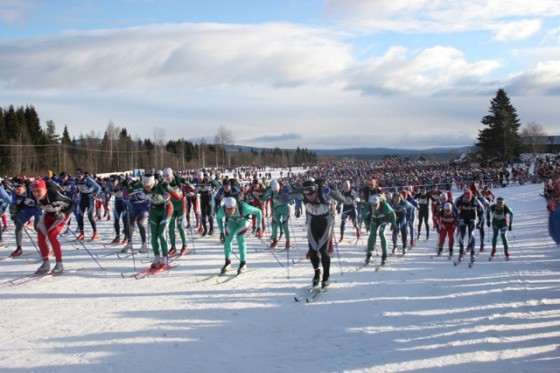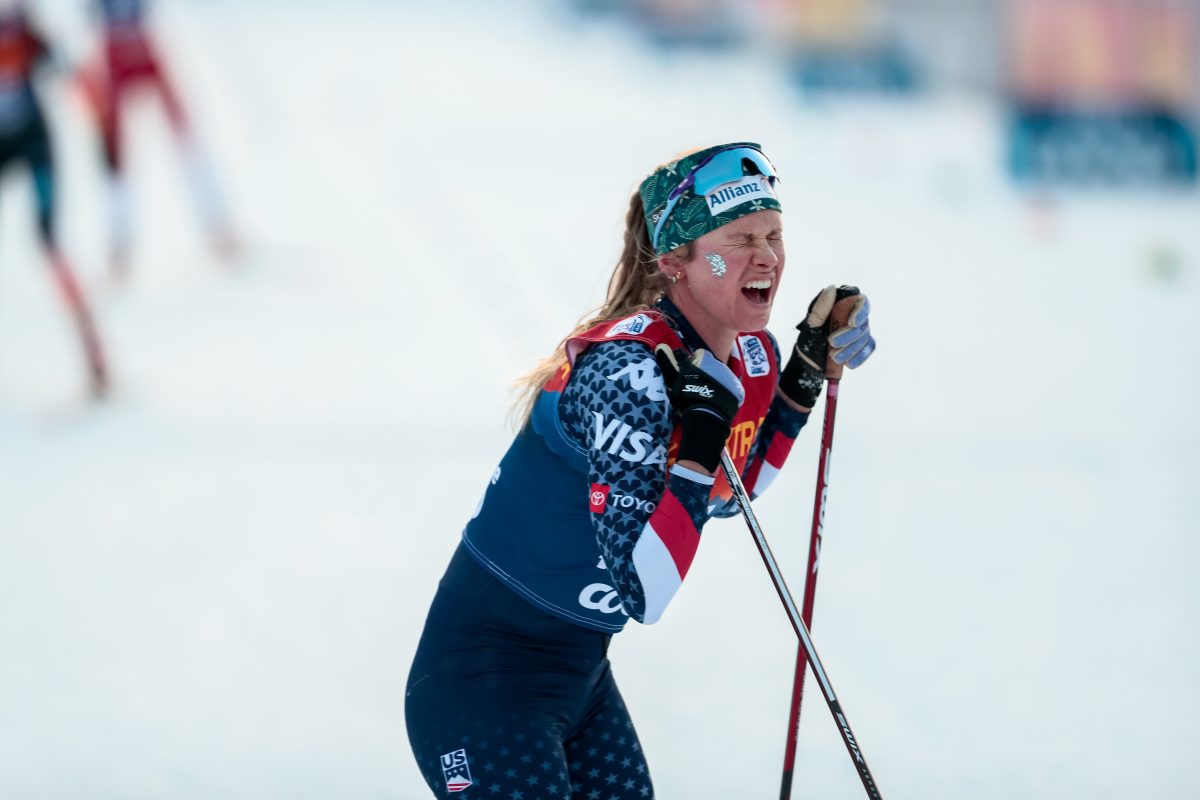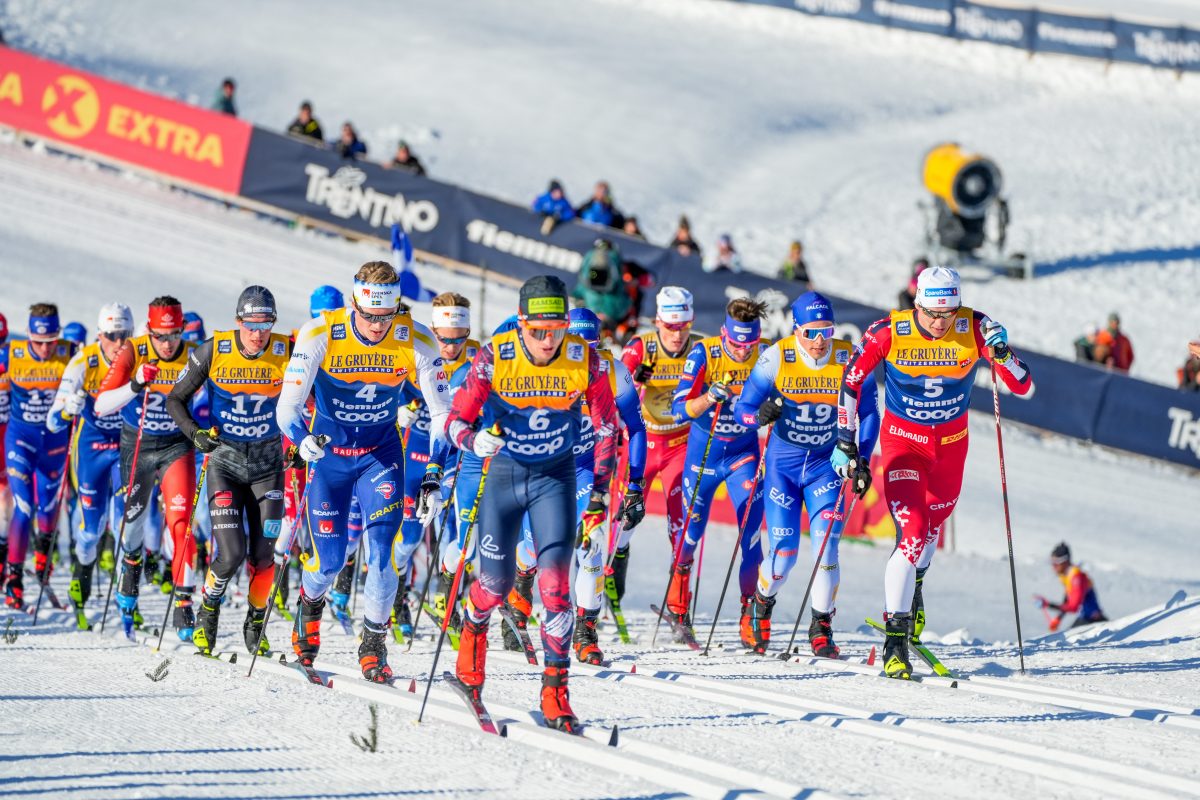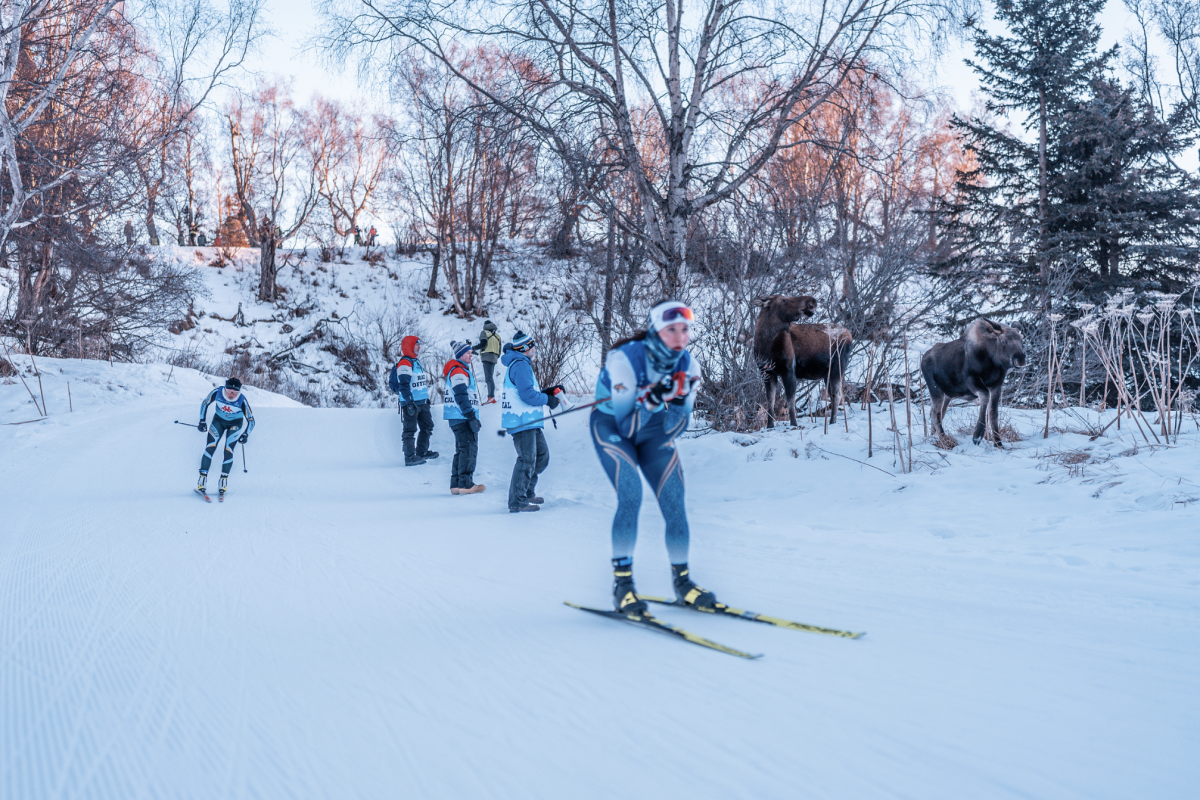
LILLEHAMMER, Norway – At some point, a ski race just can’t have any more participants. For Norway’s Birkebeiner, that point is 17,000 racers.
“That is for the time being as big as it will be,” Birkebeiner Managing Director Rune Bergsodden told FasterSkier. “It’s the logistics of before the race and after the race; we are working on the course to get even more tracks over the mountain, but we have to take care of people, so it’s many people and many that need to have a shower and get some food.”
So if no more participants will be added to the race, held in March every year from Rena 54 kilometers over the mountains to Lillehammer, how can the organization grow?
That’s the challenge that Bergsodden and the Birkebeiner staff have embraced. And they’ve found success: although the Birkebeiner organization itself is owned by the local ski clubs in Lillehammer and Rena, for the last several years it has brought in big enough profits to give money back to the clubs as a sponsor of sorts. More than 60,000 people participate in Birkebeiner events throughout the year, and the event’s prestige is on the rise.
A Growing Race(s)
The story of the Birkebeiner is probably known to most ski fans, even in North America. In the year 1206, two warriors skied the infant prince Håkon Håkonsson over the mountains to safety, first to Lillehammer and then further north. The 54 kilometer race, first run in 1932, commemorates that journey, and participants must carry a 3.5 kg backpack (a little under eight pounds) to symbolize the weight of baby Håkon.
While the tie to Norwegian history is important, the race hasn’t always been as popular as it is now. The tradition was mainly of interest to Norwegians, and indeed to men. There wasn’t a women’s winner crowned until 1976; the first non-Norwegian man to take home the title was Sweden’s Sven-Åke Lundbäck in 1981.
And as recently as the early 2000’s, there were just over 10,000 participants per year. That number has swelled recently, which Bergsodden said was due to a number of things. One is that the race is much better organized than it was in the beginning, and, as he said, the staff focus on taking care of participants for their whole stay.
“I think we have a good race which attracts people in the way we do things,” he said in an interview in his office in downtown Lillehammer. “We have market reviews after every event we’ve done, so we know what people think about us and what has been going well and not so well. We have to improve the whole time.”
The Birkebeiner proper has now surpassed the Vasaloppet as the biggest ski race in the world; the Swedish 90-kilometer marathon is capped at 15,800 racers this year. Both events draw in many more participants with their other races throughout the week leading up to the title competitions, and Bergsodden confirmed that he and his counterparts at the Vasaloppet work together to share ideas and strategies.
For both, the increased number of events have been key to growth and success. The Birkebeiner also has a running race and a mountain biking race, which is the biggest in the world with over 15,000 finishers in recent years.
“We’re working on the concept of many races, and that will increase our numbers for the coming years, hopefully,” Bergsodden said.
While those events are scattered throughout the year, many are concentrated around the original Birkebeiner. For instance, 2013 will be the fifth year of the Birkebeiner Ski Festival, which starts the weekend before the Birkebeiner itself.
“On Saturday have the Inga-Låmi for women, which has about 3,500 participants, then on Sunday we have the youth race which also has about 2,000 participants,” Bergsodden said. “We have something called the half Birken, which is half the distance of the Birkebeiner, and then we have the children’s race.”
They’ve recently added two new formats as well. There is an open race on Friday, the day before the Birkebeiner, that appeals to less competitive skiers.
“We have timekeeping, the feed stations as on Saturday,” Bergsodden said. “That’s a little bit more calm and quiet, but just to take the challenge to pass over the mountains. For those who aren’t that focused on the timing and the Birkebeinermarke, the Friday could also be a nice day for a race – a way to do the race one day before when the tracks are still nice.”
The Vasaloppet also has this option, with both a Sunday and Monday “open track” for those who aren’t looking to win the real race or ski on the same day as the elite competitors. According to Bergsodden, the Friday race was well-received in its first outing and the organization hopes it will continue to grow, particularly for women, who represent only 20 % of the entrants in the Birkebeiner proper.
Another new event is the relay, which divides the length of the course into four parts.
“It’s for companies, and they also want to encourage their employees to do the race,” the director explained. “The shortest one is nine kilometers, and anyone can do that. So that’s also a way to get people into our races. This could be an introduction for them to do the whole race.”
Every once in a while, of course, there’s an idea that doesn’t work. One of these was the skate Birkebeiner, which was canceled after a few years for lack of interest in the classic-style country.
“We are an organization that works on getting events with big numbers,” Bergsodden said. “For us it is not worth it to organize a race with 100 participants – that’s for the local ski club.”
Cultural Touchstone
The Birkebeiner may be famous around the world, but it’s still a primarily Norwegian event. Only about 1,000 of the competitors are international, and it is Norway itself which has built the numbers up so quickly. Aside from new race formats and good organization, the newfound popularity is also partly due to changes in society and priorities in the country itself. Health and fitness are have become more of a focus for a larger segment of the population, for instance.
“The main reason why people get registered is to have a motivating goal for their training,” Bergsodden explained. “We have a society where we are sitting, and we are getting fatter. So it’s very important that we exercise, and I think people are more focused on this now, they are living healthy and have some training goals. And competitions are for sure a training goal… this was positive for us.”
That’s true across sports, not only in Norway but other countries, and it’s especially true for skiing, says Bergsodden. It’s easy to assume that since Norway is the sport’s origin and the country is so successful at the elite level, everyone in the small country must support and participate in the sport. That hasn’t always been true – and the many recreational skiers don’t necessarily race – but the sport is coming back, said the director.
And the Birkebeiner is a big part of that. It’s important to be able to tell friends and co-workers that one not only completed the race, but perhaps got the “mark” – a time calculated as an addition 20% of the time of the top five finishers in each age group.
Racers can also compare their times to the elite skiers that they see on TV throughout the winter. There’s a reason that Marit Bjørgen and Petter Northug have such lucrative careers, and it’s the fanbase in Norway; while neither have focused on the Birkebeiner, which usually conflicts with late-season World Cup racing, other Norwegian ski celebrities like Hilde Petersen, Odd-Bjørn Hjelmeset, and Anders Aukland have won in the last decade. When the marathon was incorporated into the World Cup calendar in 2002,
“Here you can compete with the best, because the elite skiers are also coming,” Bergsodden said. “So as a citizen skier you can compare with the World Cup skiers and see how you are doing. That is also important for a lot of the skiers.”
And besides World Cup skiers, marathon skiers are gaining more and more fans now that the Birkebeiner and other long-distance races are being broadcast on television around Europe.
“TV coverage is rather important for us,” Bergsodden said. “Before you had the World Cup skiing, but now we also have long-distance skiing, and that has been developing on TV. They’ve done a great job to show the races. It’s completely different from a World Cup race… it’s more focused in newspapers and in the media in general. Interest in cross country skiing in Scandinavia is increasing.”
This has been so thoroughly integrated into ski and training culture that some sponsoring companies have their employees take part. In these cases there is honor on the line. But, says Bergsodden, there’s also a big benefit.
“Companies use it as motivation for their employees,” he explained. “They’ve looked into it and the percentage of sick days are decreasing, so this is important. They are spending quite a bit of money on this, but they are saving money.”
Who Gets to Race?
With the race selling out in hours and some people who want to participate always denied, someone has to regulate the 17,000 people who do get to toe the starting line. Everything leading up to the start is organized carefully and systematically.
For instance, if a racer can’t start – maybe they end up having another commitment on Birkebeiner weekend – they don’t just lose their entry money. The organizers realized that it was important to work around this and offer the spot to someone else, without allowing scalping for entries.
“We start registration almost one year ahead,” Bergsodden said. “Many maybe get sick or get pregnant and can’t race, so we have a place on the website so that you can sell your place in the race. They are selling their place to someone else, and you have to pay a fee of 200 kroner to get the new registration.”
Entries are changed to the new name and even re-seeded. And that brings up something else: seeding. How do you start 17,000 racers in an organized fashion? 30 waves of skiers go off at five-minute intervals: “you start when you are expected to finish,” the director explained. A previous Birkebeiner time can be used for seeding, or any of the 15 or so races around Norway that are deemed seeding race. Times from other Worldloppet marathons are also eligible.
About 70 percent of participants have seeding times, and Bergsodden said that “it’s a lot of work” to divide them properly into waves, but there’s relatively little arguing with the system. It’s based on times in the seeding races and comparisons with times of other racers in both that specific race and the Birkebeiner the year before; place, for instance, is largely irrelevant.
The seeding system began around 2005, before which starts were based on age categories. The new system has fed into the sport’s growing presence in Norway.
“We changed that and at that time, the tours were decreasing in terms of participants,” Bergsodden said. “But after we started with the seeding competitions, they have been increasing. Some have doubled or tripled their numbers. This has been nice for cross country skiing in general.”
Running Smoothly
With thousands of competitors expecting a good weekend in Lillehammer and many Norwegians depending on the opportunity to vanquish their friends and co-workers in a ski race, it’s important that things go according to plan. Only once, in 2007, was the race canceled or cut short; on that occasion winds topped 50 miles per hour in the 1,000-meter tall mountains between Rena and Lillehammer.
Even that cancellation didn’t go over well in Norway. A small group of racers pushed on even though officials tried to force them to turn back, then gave interviews to the media criticizing the decision.
Weather isn’t something that organizers can control, but it’s also not something they worry about too much. Going over 1,000 meters in March this far north, for instance, means the race will be less sensitive to climate change than some other ski events. The weather has always varied, and will continue to do so.
“You can see the picture up there: the first winner of the Birkebeiner in 1932,” Bergsodden said, gesturing to a photo of a serious-looking Norwegian man skiing by a row of shouting spectators; dirt pokes up through the snow. “We can have some challenges with snow, but we are up in the mountains, so we’re pretty safe.”
Instead of planning for future warmer winters, organizers are focused on more concrete challenges.
“It’s much more than twice as much work, especially with transportation,” Bergsodden said of the point-to-point format. “We have no roads over the mountain, so they have to go 90 k around. To get the clothing before the people come to the finish line is hard… the background of the race is how to get the king’s son over the mountain. We can’t change that, but for us as organizers it would be much easier to have the start and finish in one place and also a lot cheaper way to organize things.”
(Luckily, it’s required to bring warmups in each racer’s backpacks, so there’s a guarantee of at least a warm jacket at the finish line.)
For that, the Birkebeiner relies on volunteers and the local ski clubs. Some are paid, not personally, but to the sports or civic organization that agree to donate members’ time. The 20 Birkebeiner competitions, drawing over 60,000 participants, require 7,000 volunteers. Luckily, Lillehammer and the surrounding region have a long history of hosting large sporting events, so there are many who are ready, willing, and knowledgeable to help.
That keeps things running smoothly for not only the race, but Birkebeiner week.
“We are looking into the whole stay, from when you come to Lillehammer until you leave,” Bergsodden said. “So it’s not only the race but the whole weekend because people are coming here and having a nice time.”
Chelsea Little
Chelsea Little is FasterSkier's Editor-At-Large. A former racer at Ford Sayre, Dartmouth College and the Craftsbury Green Racing Project, she is a PhD candidate in aquatic ecology in the @Altermatt_lab at Eawag, the Swiss Federal Institute of Aquatic Science and Technology in Zurich, Switzerland. You can follow her on twitter @ChelskiLittle.




One comment
caldxski
February 5, 2013 at 7:00 pm
caldxski says:
February 5, 2013 at 6:58 pm
The baby Hakon weighed about 11 lbs when I skied the Birkie in Norway. Now I know that was a long time ago, but did he actually lose that much weight?